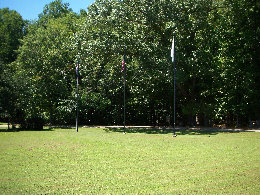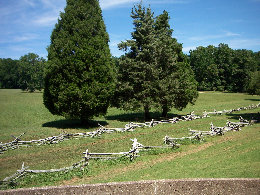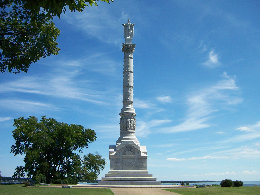


Yorktown, VA
After two years of fighting in the south, the British retreated to Yorktown where they intended to rest for a while before being picked up by their navy & heading to New York to re-engage the Americans there. But George Washington decided to take the battle to the British & finish things once & for all. By now the French had fully committed to the American cause & sent a force of 30 warships to the Chesapeake Bay where both the James & York Rivers meet & surround the peninsula. The French were led by General Rochembeau, the Americans by General Washington & the British by Lord Cornwallis. These three military giants would meet in what would be the last major battle of the American Revolution. The plan was that the French navy would block the British navy from the south & Washington would advance from the north, trapping the British with overwhelming numbers. It's a testimony to the arrogance of the British that they would choose to rest on an indefensible peninsula but they fully expected their navy to rescue them & the American navy posed little threat. When the British navy did arrive, they found the French navy blocking the Chesapeake Bay & the outnumbered British had no choice but to flee. At this point the American & French artillery were bombarding the British...pounding, then advancing...pounding, then advancing. According to Henry Knox, 15,000 artillery rounds were fired during the nine day siege. The final storming of the British redoubt ended in bloody hand-to-hand bayonet combat. While the battle raged, General Cornwallis was orchestrating things from the home of Thomas Nelson, Jr, commander of the Lower Virginia Militia. It was Nelson himself who gave the command to fire on his own house. The british eventually surrendered on October 19th, 1781. Cornwallis sent his deputy General O'Hara to surrender to Rochambeau. But, Rochambeau's aide Matthew Dumass said, "You are mistaken, the Commander in Chief of our army is to the right" & escorted him to General Washington. But Washington did not want to accept the surrender from an aide. He wanted Cornwallis but was told that he was ill. Upon hearing news of the surrender, the British Prime Minister is reported to have said, "Oh God, it's all over!" Skirmishes would continue in the south until the signing of the Treaty of Paris, September 3rd, 1783. Eight long years of bloody battle was over & a new independent nation was born!
Surrender Field - It was here that Cornwallis' aide Matthew Dumass met with Washington to surrender
This is the location where the British soldiers marched to officially surrender their arms to Washington.
Yorktown Victory Monument
"I have the honor to inform Congress, that a reduction of the British Army under the command of Lord Cornwallis, is most happily effected."
General George Washington to the President of the Continental Congress October 19, 1781
"I have the mortification to inform Your Excellency, that I have been forced to give up the posts of York & Gloucester, and to surrender the troops under my command by capitulation to the combined forces of America and France."
Lieutenant General Charles Lord Cornwallis to General Sir Henry Clinton, Commander in Chief British Forces in America October 20,1781

This simple cross is thought to mark the burial place of about 50 unidentified French soldiers killed during the siege of Yorktown
Click image to enlarge



